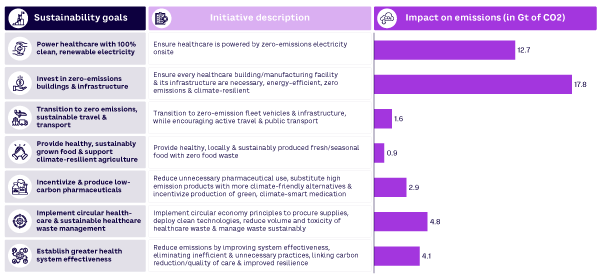The healthcare sector can embrace sustainability without compromising quality of care or impairing patient experience (see Figure 1). Advances in green technologies such as alternative energy sources, water conservation systems, and waste-reduction measures, particularly in sterile zones such as operating rooms, offer significant potential for reducing environmental impact.

International energy regulations and standards provide complementary guidelines that can be integrated into broader sustainability efforts. Infrastructure and real estate standards such as LEED (Leadership in Energy and Environmental Design) inform energy-efficient building design; ASTM (American Society for Testing and Materials) provides standards for environmental site assessments; and BREEAM (Building Research Establishment Environmental Assessment Method) certifies the sustainability performance of buildings. From a management perspective, International Organization for Standardization (ISO) 14001 provides a framework for organizations to improve their environmental performance, and the US program Energy Star certifies energy efficiency.
The Global Green and Healthy Hospitals (GGHH) network and the International Hospital Federation (IHF) also provide resources to help hospitals reduce their environmental footprint as part of a knowledge-sharing community. These standards yield substantial cost savings, enhance operational efficiencies, and encourage cross-industry collaboration and partnerships that can drive systemic change and innovation in sustainable healthcare practices.
We can also look to leading healthcare organizations that have successfully integrated sustainable practices into their operations:
-
The University Medical Center of Princeton (New Jersey, USA) reduced energy use by 30% with sustainable design features like a green roof and energy-efficient lighting.
-
Cleveland Clinic (Ohio, USA) installed LED lights and solar arrays, reducing its energy use and GHGs by 30%. By replacing disposable items with reusable or compostable alternatives, the Mount Sinai Health System reduced its use of single-use plastics and cut waste by 15% in the first year.
- The Lucile Packard Children’s Hospital Stanford in California, USA, implemented a comprehensive water management plan that reduced its water usage by 38%.
-
National Health Service (NHS) England, which is responsible for more than 500 hospitals, is targeting net zero emissions by 2040 for Scope 1 and 2 and by 2045 for Scope 3. Strategies such as reusing medical instruments have saved more than £250,000 annually for some hospitals.
At a national level, the UK’s NHS Sustainability Action Plan and the US’s Sustainability Action Plan aim to reduce the sector’s carbon footprint and enhance sustainability. Both plans include a variety of initiatives, from energy efficiency and transportation to sustainable procurement and partnerships. Each plan addresses unique regional challenges, but they share the overarching goal of achieving net zero emissions and promoting environmentally responsible healthcare practices.
[For more from the authors on this topic, see: “Greening Healthcare.”]




